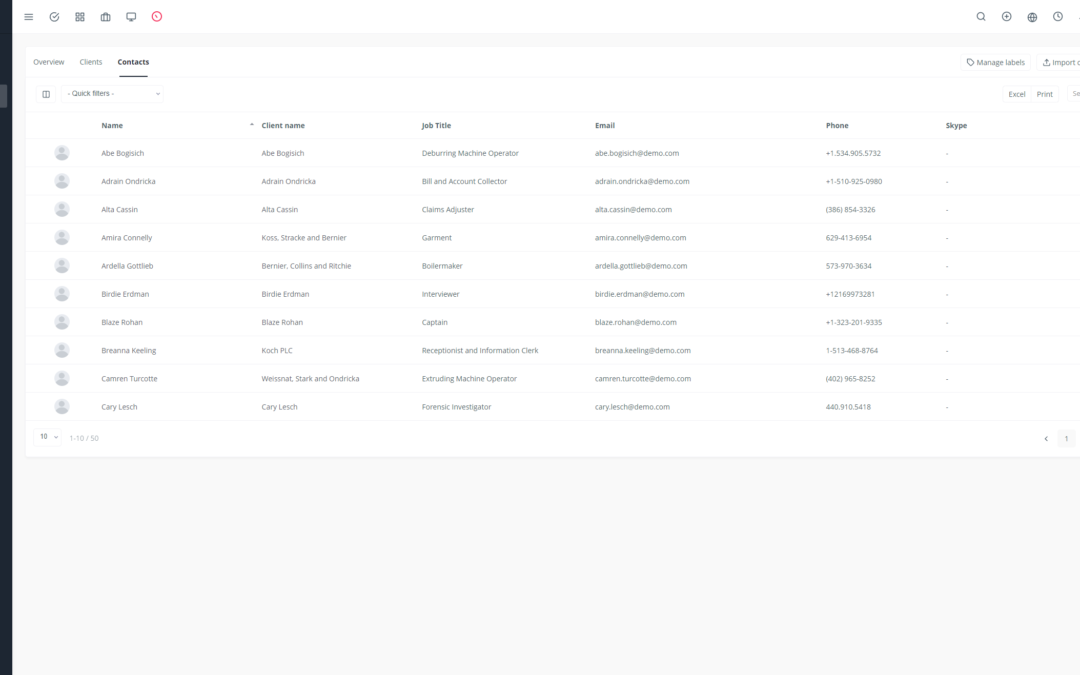In a world of fierce competition and increasingly demanding customers, businesses must find ways to boost their efficiency and stand out. Collaboration among teams is crucial to achieving these goals.
A CRM (Customer Relationship Management) is more than just a customer relationship management software. It’s a powerful tool that fosters collaboration and aligns the efforts of all departments toward a single vision: customer satisfaction.
Here’s how a CRM can transform your business into a high-performing collaboration machine:
1. Improved Internal Communication 💬
The CRM becomes a central communication hub for sales, marketing, and customer service teams. Imagine:
Sales: “I need to know this customer’s history to better advise them.”
Marketing: “What is the conversion rate of our latest campaigns?”
Customer Service: “This customer has already contacted customer service, what were their previous requests?”
The CRM answers these questions instantly, thanks to a shared database accessible to everyone.
2. Centralized Information Sharing 📂
The CRM becomes the single repository for all customer information.
No more information silos: teams access the same data and the same version of the truth.
Time and efficiency gains: no more searching for scattered information in different documents or emails.
3. Collaboration on Customer Accounts 🌟
The CRM facilitates the management of important customer accounts.
Team collaboration: teams can work together to develop strategies, track project progress, and share critical information.
Better understanding of customer needs: the holistic view allows for more tailored solutions and increased satisfaction.
4. Process Automation 🤖
The CRM automates repetitive and time-consuming tasks, freeing up time for collaboration.
Automatic follow-up email sending
Report generation
Customer data updates
This time savings allows teams to focus on higher-value tasks, such as strategy and problem-solving.
5. Performance Tracking and Analysis 📊
The CRM provides powerful tracking and analysis tools to measure the impact of collaboration.
Measure customer satisfaction
Identify weaknesses
Improve processes
By analyzing data, teams can pinpoint areas for improvement and optimize their actions to maximize efficiency.
6. Shared Lead Management 🧲
The CRM enables sales and marketing teams to collaborate effectively on potential leads.
Lead information sharing
Lead progress tracking
Lead assignment to the right salespeople
This collaboration optimizes lead conversion and increases sales rates.
7. Marketing Campaign Collaboration 🎯
The CRM is a valuable tool for planning and executing coordinated marketing campaigns.
Customer segmentation
Creating personalized campaigns
Tracking campaign performance
Collaboration between marketing and sales allows for sending relevant messages to the right customers at the right time, maximizing campaign impact.
8. Customer Ticket Management 🆘
The CRM allows sales and customer service teams to collaborate effectively to resolve customer issues.
Customer ticket sharing
Request progress tracking
Escalation management
This collaboration ensures quick and efficient resolution of customer issues, improving their satisfaction and loyalty.
9. Customer Data Integration 🧩
The CRM unifies customer data from various sources, providing a holistic and consistent view of the customer.
Merging data from different systems
Creating a complete customer profile
Better understanding of customer needs and preferences
10. Customer Experience Personalization 🎁
The CRM allows teams to personalize customer interactions based on their needs and preferences.
Personalized offers
Personalized messages
Unique customer experiences
Personalization strengthens the customer relationship and increases satisfaction.
11. Enhanced Customer Satisfaction 🤩
Collaboration among teams through the CRM creates a positive and consistent customer experience.
Reduced problem resolution time
Increased interaction quality
Better understanding of customer needs
A positive customer experience is essential for retaining customers and turning them into brand ambassadors.
12. Contact and Customer Relationship Management 🤝
The CRM is a powerful tool for establishing and managing lasting customer relationships.
Contact management
Customer segmentation
Communication automation
By using the CRM, teams can build deeper and more personalized relationships with their customers, increasing loyalty and lifetime value.
13. Customer Segmentation 📊
The CRM allows you to segment customers based on their characteristics and behaviors, enabling you to personalize communications and offers.
Segmentation by age, gender, location, interests
Creating personalized marketing campaigns
Offering solutions tailored to the needs of each segment
Segmentation improves the efficiency of marketing campaigns and increases profitability.
14. Marketing Automation 📧
The CRM automates marketing tasks, such as emails and SMS campaigns.
Creating automated marketing campaigns
Sending personalized messages
Performance tracking
Marketing automation saves time, reduces costs, and improves campaign effectiveness.
15. Sales Tracking and Analysis 📈
The CRM allows you to track sales performance and identify opportunities for growth.
Sales pipeline tracking
Analysis of salesperson performance
Identifying areas for improvement
By analyzing sales data, teams can optimize their strategies and improve their results.
16. Sales Pipeline Management 🎯
The CRM allows sales teams to manage and track sales opportunities.
Tracking sales process steps
Prioritizing opportunities
Forecasting future sales
Effective sales pipeline management increases conversion rates and generates additional revenue.
17. Sales Forecasting 🔮
The CRM predicts future sales and improves planning.
Analysis of historical sales data
Predicting future trends
Improving sales planning
Accurate forecasts enable teams to make more informed decisions and optimize their sales efforts.
18. Inventory and Supply Chain Management 📦
The CRM can be used to manage inventory and the supply chain.
Inventory tracking
Order management
Supply chain optimization
Effective inventory and supply chain management reduces costs, improves efficiency, and provides a better customer experience.
19. Data Analysis and Reporting 📊
The CRM is a valuable source of data for analysis and reporting.
Creating custom reports
Trend analysis
Identifying areas for improvement
CRM data enables more informed decisions and improves business performance.
20. Improved Decision-Making 🧠
The CRM allows teams to make more informed decisions based on customer data.
Better understanding of customer needs and preferences
Identifying market trends
Making data-driven decisions
By relying on objective data, teams can optimize their strategies and improve their results.
In conclusion, the CRM is an indispensable tool for any business looking to enhance collaboration and customer satisfaction.
By investing in a CRM, you pave the way for sustainable growth and increased success. 🎉

